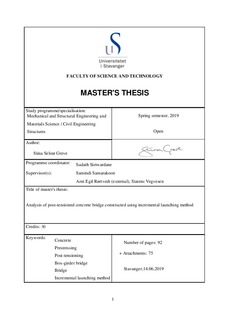| dc.description.abstract | The aim of this thesis is to gain a broader understanding of bridge construction methods and to analyse a bridge constructed in stages. To do so, a model is created for analyses in the frame software NovaFrame.
The bridge which is to be analysed in this thesis is Bagn bridge, a three-span bridge which is already constructed using the movable scaffolding system. In cooperation with the Norwegian public road administration, the bridge is to be analysed by using the incremental launching method (ILM).
First, a literature review is performed to collect relevant information about the project, relevant regulations, materials, construction method and methods for analysis.
When using ILM, the bridge is casted in segments in a casting yard at one end of the bridge and is launched after the concrete has reached satisfying strength. Due to the fact that the casting is done in a casting yard and that the bridge is launched over pre-casted piers, this method has little effect on the surrounding environments. This makes this method highly efficient when casting over for example highways and railroads.
One of the mayor parts of this thesis was to create analytical models in NovaFrame. The models were based on detail drawings handed out by the Norwegian Public Road Administration (SVV) but were adjusted to be suitable for ILM. Two models were made, one model for the bridge during launching and one model for the final bridge construction. The reason for this is to have full control of loads and load combinations, as the launching stages requires many load-cases.
22 centric pre-stressing tendons were used during launching, whereas 14 were placed in the top flange of the box girder and 8 were placed in the bottom. Two pre-stressing tendons were placed in each web to be post-tensioned after the final launch.
Capacity controls were performed at ultimate limit state (ULS) and serviceability limit state (SLS) for both the launching stages and the final construction. Simplified load combinations were used for the launching stages, as most of the variable loads were neglected due to the fact that most of the variable loads would have small effects on the structure.
Results from calculations at ULS for the launching stages showed that the predefined number of prestressing tendons were sufficient with additional reinforcement over supports. Additional shear reinforcement was also necessary. At SLS, the section was found to be uncracked. Stress limitations were neglected for the launching stages. The stress limitations are performed to at construction stages to limit cracks and large deformations due to creep. As the stress limitations are valid for cracks which are smaller than the allowable cracks during constriction, they are not considered relevant during launching.
For the final construction, more load cases were introduced. Variable loads such as wind, traffic and creep were included in this analysis. For ULS, calculations showed that excessive reinforcement was needed in span. From shear calculations, additional shear reinforcement was required. A more excessive control at SLS were performed, and in addition to the crack control, decompression, stress limitation and deflection control were done. The analysis of cracked section proved that the section was to be considered as uncracked. Therefore, stresses taken directly from NovaFrame were sufficient for further analysis. Decompressions gave satisfying results, but for the stress limitations for quasi permanent load combination showed that extra reinforcement over support 2 were necessary. | nb_NO |

